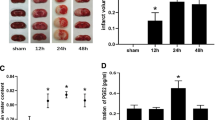Abstract
We investigated the distribution and time course of expression of two subtypes of prostaglandin E2 (PGE2) receptors, EP2 and EP4, in a rat model of cerebral ischemia and ischemic tolerance. Adult male Sprague-Dawley rats were subjected to either lethal global ischemia (10 min) with or without sublethal ischemic preconditioning (3 min), or ischemia only (3 min). A short 3-min cerebral ischemia and a 3-min ischemia followed by a second lethal ischemia enhanced the expression of EP2 and EP4 receptors in CA1 pyramidal neurons of the hippocampus. In tolerance-acquired CA1 neurons, the immunoreactivities of EP2 and EP4 were upregulated after 4 h and 12 h, respectively. The immunoreactivities were most prominent at 3 days and were sustained for at least 14 days, consistent with results of immunoblotting experiments. However, immunoreactivities for these PGE2 receptors increased in reactive glial cells in the vulnerable CA1 and hilar regions of rats subjected to lethal ischemia without ischemic preconditioning. Most of the EP2 immunoreactivity occurred in microglial cells and some astrocytes, whereas increased immunoreactivity for EP4 was found only in astrocytes. These data suggest that ischemia and the induction of ischemia tolerance have different regulatory effects on the expression of EP2 and EP4 receptors. Moreover, PGE2 may exert its unique pathophysiological functions in relation to delayed neuronal death and ischemic tolerance induction in the rat hippocampus via specific PGE2 receptors.






Similar content being viewed by others
References
Bilak M, Wu L, Wang Q, Haughey N, Conant K, St Hillaire C, Andreasson K (2004) PGE2 receptors rescue motor neurons in a model of amyotrophic lateral sclerosis. Ann Neurol 56:240–248
Blatteis CM, Sehic E (1998) Cytokines and fever. Ann N Y Acad Sci 840:608–618
Caggiano AO, Kraig RP (1999) Prostaglandin E receptor subtypes in cultured rat microglia and their role in reducing lipopolysaccharide-induced interleukin-1beta production. J Neurochem 72:565–575
Candelario-Jalil E, Gonzalez-Falcon A, Garcia-Cabrera M, Alvarez D, Al-Dalain S, Martinez G, Leon OS, Springer JE (2003) Assessment of the relative contribution of COX-1 and COX-2 isoforms to ischemia-induced oxidative damage and neurodegeneration following transient global cerebral ischemia. J Neurochem 86:545–555
Choi J-S, Kim SY, Cha J-H, Choi Y-S, Sung K-W, Oh ST, Kim ON, Chung J-W, Chun M-H, Lee SB, Lee M-Y (2003) Upregulation of gp130 and STAT3 activation in the rat hippocampus following transient forebrain ischemia. Glia 41:237–246
Dooley P, Corbett D (1998) Competing processes of cell death and recovery of function following ischemic preconditioning. Brain Res 794:119–126
Dore S, Otsuka T, Mito T, Sugo N, Hand T, Wu L, Hurn PD, Traystman RJ, Andreasson K (2003) Neuronal overexpression of cyclooxygenase-2 increases cerebral infarction. Ann Neurol 54:155–162
Ferreira SH, Moncada S, Vane JR (1973) Prostaglandins and the mechanism of analgesia produced by aspirin-like drugs. Br J Pharmacol 49:86–97
Ferreira SH, Nakamura M, de Abreu Castro MS (1978) The hyperalgesic effects of prostacyclin and prostaglandin E2. Prostaglandins 16:31–37
Hayaishi O, Matsumura H (1995) Prostaglandins and sleep. Adv Neuroimmunol 5:211–216
Kato H, Kogure K, Liu Y, Araki T, Itoyama Y (1994) Induction of NADPH-diaphorase activity in the hippocampus in a rat model of cerebral ischemia and ischemic tolerance. Brain Res 652:71–75
Kim SY, Park H-J, Choi J-S, Lee JE, Cha J-H, Choi Y-S, Cho K-O, Chun M-H, Lee M-Y (2004) Ischemic preconditioning-induced expression of gp130 and STAT3 in astrocytes of the rat hippocampus. Mol Brain Res 129:96–103
Kitagawa K, Matsumoto M, Tagaya M, Hata R, Ueda H, Niinobe M, Handa N, Fukunaga R, Kimura K, Mikoshiba K, Kamada T (1990) “Ischemic tolerance” phenomenon found in the brain. Brain Res 528:21–24
McCullough L, Wu L, Haughey N, Liang X, Hand T, Wang Q, Breyer RM, Andreasson K (2004) Neuroprotective function of the PGE2 EP2 receptor in cerebral ischemia. J Neurosci 24:257–268
Nakayama M, Uchimura K, Zhu RL, Nagayama T, Rose ME, Stetler RA, Isakson PC, Chen J, Graham SH (1998) Cyclooxygenase-2 inhibition prevents delayed death of CA1 hippocampal neurons following global ischemia. Proc Natl Acad Sci USA 95:10954–10959
Narumiya S, Sugimoto Y, Ushikubi F (1999) Prostanoid receptors: structures, properties, and functions. Physiol Rev 79:1193–1226
Nogawa S, Zhang F, Ross ME, Iadecola C (1997) Cyclo-oxygenase-2 gene expression in neurons contributes to ischemic brain damage. J Neurosci 17:2746–2755
Perez-Pinzon MA, Xu GP, Mumford PL, Dietrich WD, Rosenthal M, Sick TJ (1997) Rapid ischemic preconditioning protects rats from cerebral anoxia/ischemia. Adv Exp Med Biol 428:155–161
Pooler AM, Arjona AA, Lee RK, Wurtman RJ (2004) Prostaglandin E2 regulates amyloid precursor protein expression via the EP2 receptor in cultured rat microglia. Neurosci Lett 362:127–130
Pulsinelli WA, Brierley JB (1979) A new model of bilateral hemispheric ischemia in the unanesthetized rat. Stroke 10:267–272
Takadera T, Yumoto H, Tozuka Y, Ohyashiki T (2002) Prostaglandin E(2) induces caspase-dependent apoptosis in rat cortical cells. Neurosci Lett 317:61–64
Takadera T, Shiraishi Y, Ohyashiki T (2004) Prostaglandin E2 induced caspase-dependent apoptosis possibly through activation of EP2 receptors in cultured hippocampal neurons. Neurochem Int 45:713–719
Xiao CY, Yuhki K, Hara A, Fujino T, Kuriyama S, Yamada T, Takayama K, Takahata O, Karibe H, Taniguchi T, Narumiya S, Ushikubi F (2004) Prostaglandin E2 protects the heart from ischemia-reperfusion injury via its receptor subtype EP4. Circulation 109:2462–2468
Zhou AM, Li WB, Li QJ, Liu HQ, Feng RF, Zhao HG (2004) A short cerebral ischemic preconditioning up-regulates adenosine receptors in the hippocampal CA1 region of rats. Neurosci Res 48:397–404
Acknowledgements
We gratefully acknowledge the technical assistance of Hee-Duk Rho and Byung-Ouk Hong.
Author information
Authors and Affiliations
Corresponding author
Additional information
This research was supported by a grant (M103KV010019 04K2201 01930) from the Brain Research Center of the 21st Century Frontier Research Program funded by the Ministry of Science and Technology of the Republic of Korea.
Rights and permissions
About this article
Cite this article
Choi, JS., Kim, HY., Chun, MH. et al. Expression of prostaglandin E2 receptor subtypes, EP2 and EP4, in the rat hippocampus after cerebral ischemia and ischemic tolerance. Cell Tissue Res 324, 203–211 (2006). https://doi.org/10.1007/s00441-005-0121-0
Received:
Accepted:
Published:
Issue Date:
DOI: https://doi.org/10.1007/s00441-005-0121-0




